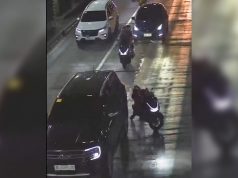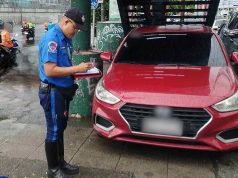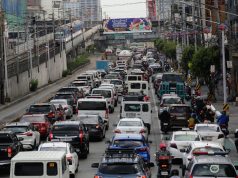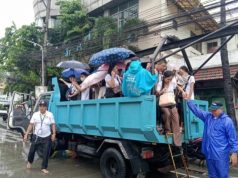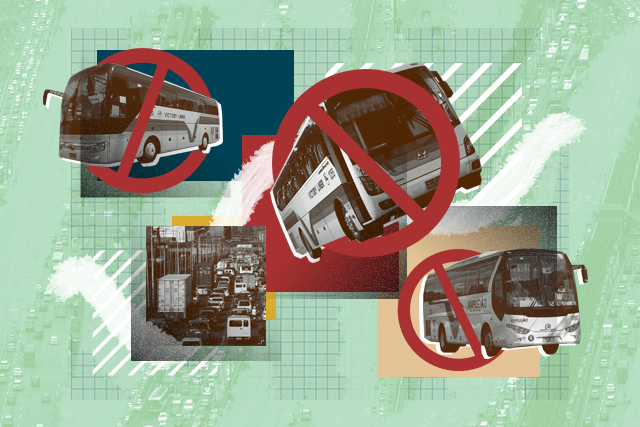
Commuters aired their concerns over the planned removal of provincial bus terminals along EDSA as it may cause them more inconvenience while the government tries to ease traffic congestion.
Metro Manila Development Authority chairman Danilo Lim said the resolution would take effect in June 2019, although a dry run would be implemented after Holy Week in April to “prepare the operators as well as the commuters.”
The Metro Manila Council, the MMDA’s policy-making body, has approved the resolution to no longer issue permits to public utility bus terminals and operators, as well as other public utility vehicles, that ply the major thoroughfare.
“Our direction is to remove all bus terminals along EDSA and relocate them to the outskirts of the metro to minimize traffic congestion,” Lim said.
A total of 96 bus terminals will be affected by the resolution, said MMDA special traffic and transport zone head Colonel Bong Nebrija.
Provincial buses from the north are expected to end their trips at the Valenzuela Gateway Complex Central Integrated Terminal while those from the south will end at the South Integrated Terminal in Sta. Rosa, Laguna and the Parañaque Integrated Terminal Exchange.
While the resolution has yet to be signed by mayors involved in the MMC, it has already gathered comments and reactions from commuters who travel along EDSA every day.
Some observed that it has been city buses and private vehicles that are the main causes of heavy traffic. Provincial buses, they say, return to their points of origin after they have picked and dropped passengers.
As of 2017, there are around 3,300 provincial buses and 12,000 city buses that ply EDSA on a daily basis.
Ang pagkakaalam ko po kasi, yung mga bus galing probinsya, kapag pupunta ng EDSA ay sa terminal na sila namamalagi, at muling babalik ng probinsya. Hindi ba’t ang mga city buses ang nagdudulot ng trapiko?
— indhieeeee (@indhiedelacruz) March 17, 2019
“Bawasan ang city buses, sila pinakamarami, e ‘yung provincial buses me (may) oras lang e, ‘yung city buses walang oras kung kailan nila trip, bias to kc (kasi) ‘yung mga may ari ng city buses pinaboran, hindi parehas,” commuter Victor Erica said.
“Mas marami ang mga city buses sa EDSA, ang mga provincial buses ay hindi na nagpipick up ng pasahero sa daan, bawasan ang city buses at maging strict sa bus lane,” Paul Genesis Gatus, another commuter, wrote.
“Kung gusto niyong lumuwag ang trapiko, mga kotse at pribadong sasakyan na iisa o dalawa lamang ang sakay ang ipagbawal ninyong bumiyahe dahil kumukunsumo sila ng mas maraming road space, hindi mga bus na 40 at higit pa ang pasahero,” commuter Nathan Guevara said.
Others claimed that it would be more tiring and costly for travelers since they would have to take multiple rides to get to their destination as an alternative.
‘Inconvenient for workers’
The MMDA in August 2018 attempted to ban provincial buses altogether in EDSA, although it only took effect during weekday rush hours, specifically from 7 a.m. to 9 a.m. and 6 p.m. to 9 p.m.
Labor group Associated Labor Unions-Trade Union Congress previously decried the ban, saying that it was “counterproductive, inconvenient, expensive, and stressful for thousands of workers.”
ALU-TUCP spokesperson Alan Tanjusay argued that commuters shelled out additional fare aside from their usual travel expenses to reach their workplaces since they took several rides as an alternative.
“Initial observation from workers showed employees living in Bulacan, Cavite and Laguna spent PHP24 to PHP36 more out of their meager minimum wage on top of their usual transportation routine expenses,” he shared.
“Aside from additional expenses, the provincial bus rush hour ban along EDSA also caused many employees to arrive late, causing salary and paid leave deductions,” Tanjusay continued.
It was eventually lifted in September 2018 after the MMDA failed to secure the interim bus terminal in Valenzuela that was supposed to act as an alternative pick-up and drop-off point to passengers in an effort to decongest EDSA.
Meanwhile, the Parañaque Integrated Terminal Exchange received lots of complaints a few weeks after it was opened on November 2018.
Commuters said that their travel time increased, as well as the amount that they have to set aside for travel due to additional costs at the terminal. — Artwork by Interaksyon/Uela Altar-Badayos





